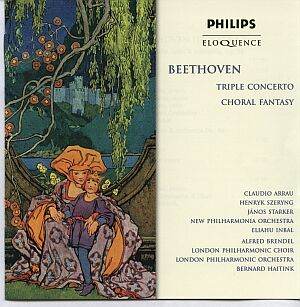What have these two pieces in common? Both were written
in 1808. Both suffer – rightly or wrongly – from being pigeon-holed
as Division 2 Beethoven or neglected masterpieces, depending on your
point of view. Both are Piano Concertos which aren’t quite Piano Concertos,
involving as they do a solo violin and cello (in the case of the so-called
‘Triple Concerto’) or a chorus (and for a mere two minutes only, in
the piece we usually refer to as the ‘Choral Fantasy’). So neither piece
fits easily or comfortably (certainly not cheaply!) into a concert programme:
and they’ve probably been overlooked by concert planners and promoters
for precisely that reason.
In truth, they’re both (in their different ways) remarkable
pieces. Take the Triple Concerto. The discreet statement of the theme
in the cellos and basses which opens the first movement is extraordinary
(both as scoring and as thinking) for its time, and the tutti which
ensues is as exciting as anything in middle-period Beethoven. And of
all the transitory middle movements which typify so much Beethoven at
this time (think of the Fifth or Sixth Symphonies, the Rasumovsky Quartets,
the Fourth Piano Concerto, the Violin Concerto, the Waldstein and Appassionata
Piano Sonatas…) this is as beautiful, as mysterious and as intense as
any. But there are times in the first movement – and longer periods
in the rondo finale – where Beethoven loses his way and falls back on
rather empty convention.
It’s interesting that no one refers to Op 56 as a ‘Piano
Trio’ Concerto; and, in truth, it is no such thing. It really is a concerto
for three soloists who, although they need to work together as a team,
as often as not take turns to enjoy the limelight. This doesn’t suit
every front-rank soloist, of course. And it doesn’t benefit the structural
integrity of the concerto either, what with so much of the material
being repeated for the different solo instruments: the result is that
our interest can be divided rather than multiplied.
The Three Wise Men in this recording include Arrau
– an over-rated artist, I’ve always thought: will the editor sack me
for saying such a thing, I wonder? He plays well – solidly rather than
subtly. Szeryng is his usual excellent self, with secure intonation
and forthright articulation in the finale. Starker plays the slow movement
main theme (high up on his A-string) with glorious tone and the breathings
in and out you’d expect from a great singer, but his tone lower down
the instrument is less refined. Inbal accompanies loyally. The sum of
all this? A well-played performance which lets you hear what Beethoven
wrote, but doesn’t go all out to ‘sell’ the piece: there are better
characterised performances available in the catalogue, even at bargain
price. Tape hiss intrudes too.
The Choral Fantasy, I would argue, is definitely NOT
second-rate Beethoven: it deserves a wider hearing. It contains one
of Beethoven’s truly great and memorable themes, a prototype for the
choral finale of the Ninth Symphony. Indeed the whole work seems like
a dry run for later things. The closing pages sound like a sketch for
the closing scene of Fidelio; real Beethovenian ‘victory’ music. And
the element of improvisation and fantasy – embracing all manner of theme-variation,
recitative and counterpoint – are a foretaste of the Third Period (the
late Piano Sonatas and String Quartets) if ever there was one.
Both Brendel and Haitink are on magnificent form here.
Assertive and spontaneous, Beethoven would have been proud of them!
And the recording sounds splendid.
This disc affords a good opportunity to hear two fascinating
and rewarding pieces which can only deepen our understanding of this
always-complex and innovatory composer.
Peter J Lawson


